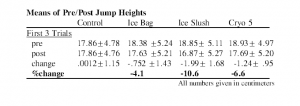Kendall J. Card and Dr. Kenneth Knight, Health and Human Performance
Cold applications are commonly used prior to strenuous physical activities due to hypalgesic effects and benefits (1). In addition to hypalgesic uses, injured athletes are often treated with cold to control inflammation. Researchers have looked into the different facets of cryotherapy, particularly applications involving the ankle due to its extremely high injury rate. Cooling the foot, ankle and/or triceps surae will yield no negative affects with regards to functional agility immediately following the application (2). Actual performance(specifically vertical jump, which is widely used basketball, volleyball, soccer, and track) following cold applications has not yet been studied. Therefore, the purpose of this study was to investigate and conclude the extent to which cold applications to the ankle affect vertical jump.
Twenty subjects (fourteen female and six male) with athletic backgrounds, were each tested during four different treatment sessions following an orientation session and the signing of a “consent to be a research subject” release form. The testing and measuring of vertical jump height took place in a biomechanics lab in the Richards Building. Initially, the height of each jump was to be measured using a vertical jump measuring stick or vertex. Since this method wasn’t completely accurate and precision was difficult, a force plate with computer readout was used as the measuring device. The vertex was used as an incentive for jumping higher but was not used as the data gathering device. Each treatment session started by having the subject do ten single leg jumps, which was followed by a fifteen minute treatment, then concluded by ten more jumps, all jumps being performed on the force plate. Prior to each jumping session, both pre and post treatment, the subjects were given ninety seconds to do three deep knee bends, three small hops, and to walk twenty feet to the force plate. A rest period of twenty-five seconds between each jump was allowed.
Four treatments were as follows: 1. Control- no treatment was administered. Subjects sat during the treatment time. 2. Ice Bag- subjects had an ice bag placed over the lateral portion of the ankle. 3. Ice slush- while wearing a neoprene bootie covering the toes and forefoot, the subject’s foot was immersed in a bucket of ice/water slush which covered the lateral ankle. 4. Cryo 5- a towel was immersed in a cold slush, slightly rinsed and placed over the lateral ankle. Cryo 5, a machine which blows a continuous flow of cold air over a precise area, was used to cool the lateral ankle. As previously stated, the duration of each treatment was fifteen minutes. After randomly dividing the twenty subjects into four separate groups, the order by which each group received treatments was determined by a Balanced Latin Square.
As anticipated, there was a decrease in vertical jump height following cold applications. There was no change in vertical jump height pre to post treatment during the control. The largest change of – 10.6% jump height, pre to post treatment, occurred with ice slush treatment. The change pre to post of ice bag and Cryo 5 were -4.3% and -6.6% respectively.
We conclude that jump height declines as a result of cold applications to the lateral ankle. In a pre game situation or during a practice and/or game, cold applications, particularly ice slush, would not be recommended when peak performance is desired. These findings can influence the decisions of Athletic Trainers, coaches, and athletes considering when to apply cold applications.
As a result of this study, further questions have arisen that remain to be answered. Is there an optimal temperature for cold applications to be therapeutic? Do the three cold applications in this study individually reach that optimal temperature? The answers to these questions will bring greater understanding to the rehabilitation of athletes.
References
- Evans, T.A., Ingersoll, C.D., Knight, K.L., and Worrell, T.W. 1995. The Effects of Cold Application on Functional agility. Journal of Athletic Training, 1995; 30:231-234.
- Evans, T.A., et al. 3. Ricard, Marc. Wrote and developed program for force plate. Was consulted on statistical analysis. Without the use of his Biomechanics Lab, this project would have never been completed.

